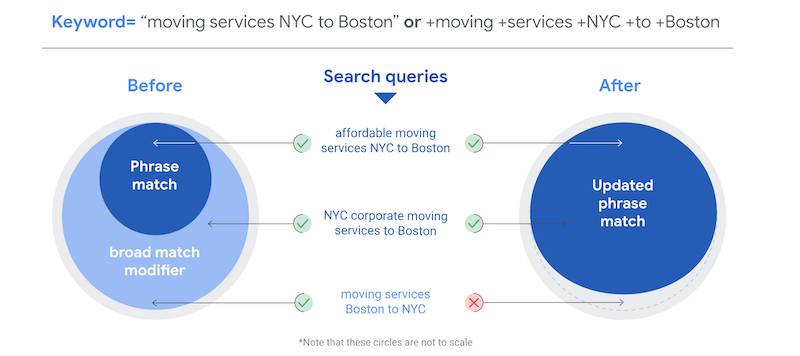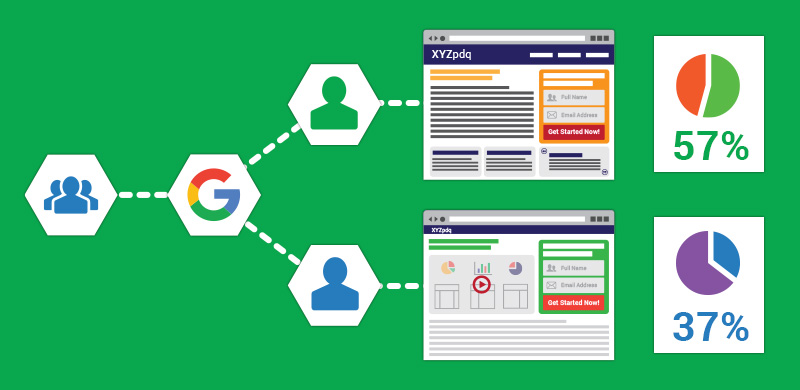The world of search is rapidly changing. As the largest stakeholder, Google is leading this movement by changing the behavior of search tactics. There is a power shift as they push for more and more automation. As these changes happen, it is more important than ever to understand what tools are available and how their behavior can impact reaching your business goals. In the following example, we tested Google Ads maximize clicks automated bid strategy and evaluated the outcome. But first, let’s review some of the changes and how you can take control back through the use of campaign experiments.
Setting the stage: The changing world of paid search
Earlier this year, Google eliminated broad modified match type. This is small but impactful step toward a keyword less world. More settings in your Google Ads accounts default to automation. And those Google Account Strategists? Always pushing ‘Smart’ campaign options. As big brands continue to pour millions of ad spend dollars into campaigns daily, automations power grasp will continue.

Image Source: https://support.google.com/google-ads/answer/10286719
But what about those of us who need to hit performance targets and understand how we get there? If giving in to the world of automation makes you uneasy, you are not alone. Simply configuring a few campaign settings, loading some ad creative, and letting Google do the rest is simply not good enough for small to medium sizes businesses. But how do you know? Google gives the ability to test automation using experiments.
Take control: Google Ads campaign experiments
If you are unfamiliar with campaign experiments, they are a copy of a campaign where campaign managers can test changes without impacting the original, or control campaign. Budgets and traffic can be split evenly creative a true split test environment.

Image Source: https://whatisthewhat.com/ab-testing-on-landing-pages/
Curious how a new landing page might perform? Set up an experiment. What about bid modifiers? Or maybe a unique ad copy idea that is too good to pass up but you are unsure how it will perform? Set up experiments. Advertisers can test any number of campaign tactics while avoiding the headaches of skewed data and sequential testing. More importantly, it gives the advertiser control over what works best for their account and business versus handing the keys over to Google.
Testing Google Ads automated bid strategies
In the following example, we had a lead generation client new to paid search. With a limited monthly budget in a very niche B2B industry, understanding how their money was spent was crucial. In our quest to prove more campaign power is better, it was a perfect time to test automated bid strategies with the help of experiments
The Set Up
Our campaigns were segmented into two groups: segmented and aggregated campaigns. Within these groups, we targeted category, subcategory, and individual product offerings. Aggregated campaigns gave Google as much control as possible while segmented campaigns retained as much control as possible. Since the client was brand new to paid search, we decided to test maximize clicks. The tests ran for 60 days.
Aggregated Campaigns
- Bidding: Maximize clicks
- Ads: Responsive
- Match types: Aggregated
Segmented Campaigns
- Bidding: Enhanced
- Ads: Expanded
- Match types: Segmented
The Results

In our Category test, Google determined only impressions were statistically significant. While overall volume was low, we had seen enough. Predictably, the aggregated campaign CPC was much higher. Google will work hard to generate clicks but will spare no expense doing so.

In our Sub Category test, Google determined all data points were statistically significant. These results surprised us. Excluding the one conversion, the aggregated campaign outperformed segmented. It generated higher engagement at a lower cost. This seems to be the perfect recipe: low cost, traffic driving keywords. This was a win. Google validated the value of these keywords by keeping costs low.

In our last test, Google determined all data points were statistically significant for our individual campaigns. Search volume was the highest and results were mixed. Although our segmented campaign generated a higher amount of clicks, engagement was not much different. Our aggregated campaign CPC was higher in this test.
Takeaways: When to Use Maximize Clicks
You often hear use maximize clicks to drive traffic as this is a common use case. It our tests, however, our enhanced bids generated 43% more clicks. Budget played a role here. Google was limited in the clicks it could generate due to a small budget. As we expected, maximize clicks spent more to achieve the desired outcome as was the result in 2 out of 3 tests.
In our sub-category test, maximize clicks outperformed, including achieving a lower cost. Why? The keywords and the variants we used kept costs low while still driving traffic. Maximize clicks validated this by generating a lower CPC then our enhanced bids.
With a new account and no conversion data, maximize clicks is a great way to drive traffic and gather initial learnings. Be mindful of Google increasing costs to achieve the outcome as maximize clicks will spend daily budgets. Understand how your budget plays a role.
Our test is a good example of how keywords have an influence on automation behavior. Think about the competition and intent of your keywords. Popular, head terms can drive up costs quickly. However, niche keywords can still drive traffic but at a lower cost. You can use maximize clicks to validate keyword performance.
Final Thoughts
As Google continues its push to more automation, it is important to understand the impact of these strategies. We are not against using automated bid strategies. Quite the opposite. We advocate always testing first, to understand the impact these strategies have on your accounts and campaigns. Use these strategies to your advantage. Looking past their goal, automated bid strategies can validate other tactics you use in your account.
For more information on Google Ads, please contact us. We are here to help.

